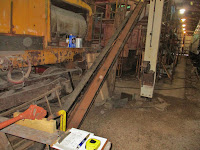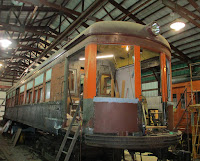Frank writes...
I was out at the museum Sunday and the property was festooned with lights. Due to the recent Covid-19 spikes, the previous Happy Holiday Railway plan that replaced the original Happy Holiday Railway plan was itself scrapped and was replaced by a drive-through tour of the property. But more on that later.
So what else was happening? When I arrived, a DC Line Department crew consisting of Richard, Greg, and Good Nick were working on the Central Avenue crossing of the trolley bus line and streetcar line. Here Greg is seen in the bucket and Richard on the ground.
They were installing connectors on the trolley bus line across the streetcar line gap. As shown here, the trolley bus line has insulators on either side of the car line so that the trolley buses - and not the much more frequent streetcars - have to "jump the gap." But when this section of the trolley bus line was "double-tracked" a few years ago, the westbound route never got connections across the gap. As such, if you're westbound (the lower-right crossing in this photo), as soon as you cross the streetcar line you're now pulling juice via the eastbound route and then around the Wagner Loop. The voltage drop from that added distance can be a problem for some of our more modern trolley buses. In short order the lower-right crossing had acquired connectors like the upper-right crossing is shown to have.
And then Richard and I got "Nicked." Nick was over at the Christ farm tearing up carpet so we went over to help with this project and also move out one of the few remaining pieces of furniture, a large couch. Rail preservation at its finest.
As soon as that job was complete we headed back to the property so that Richard could fire up the various buses and trolley buses that are being used as roadblocks to help direct auto traffic. The route of the new HHR drive-through event, called the HHR Holiday Light Experience, brings visitors' cars in through the parking lot, through the Wagner Loop gate, clockwise around the loop, down Railroad Avenue, east on Central, south on Depot Street to Springfield Avenue, and around the south end of Barn 9 to an exit by the Buildings & Grounds barn. The Seattle trolley bus shown above is parked just inside the gate at the Wagner Loop both to help direct traffic the long way around the loop and to serve as a warming station for the staff working the entrance. If you're wondering why the poles are crossed, it's because the bus has to use the bathroom.
Santa now has a CDL and is set up in the driver's seat of the trolley bus. It's appropriately signed for "Pine Street Via Snow Route."
The Dayton trolley bus that just arrived in May is parked westbound at the corner of Central and Depot to block traffic from proceeding east on Central Avenue. The driver of this one is inflatable, which I could swear I've seen somewhere before.
The event experience is still being enhanced; while Richard and I were over at the Christ farm, Greg and Good Nick were stringing more lights along the pull-offs on the Wagner Trolley Bus Loop. The effect is really impressive. The last two pull-offs will be done in time for next weekend.
And the "Jolly Polk Santa," an illuminated plastic Santa of the type so common among Chicago furniture purchasers in the 1960s, was placed securely on the motorman's stool of Veracruz 19, parked at Central Avenue. Besides the 19, North Shore 749 was parked at Springfield Avenue and a pair of 4000s were parked on the west track of 50th Avenue, all lit up of course.
Even the car shop itself was festively lit up. Make sure to tell your friends and family about the drive-through light show! It's only $10 per car and there are some very impressive displays that aren't pictured here. You'll just have to drive over and check it out for yourself.





























































